Northallerton is just a couple of miles south of our campsite. Some residents here like to show off their motors!

Totally reflective copper colour. If you look really closely you can see it’s a sort of selfie …

We entertained Wynne (another university friend) for lunch at the caravan one day in his busy schedule of singing and singing lessons. Thank you Wynne, for the lovely fruit cake from Betty’s.
On National Bee Day, we visited Nonnington Hall, a National Trust property located close to Sutton Bank.
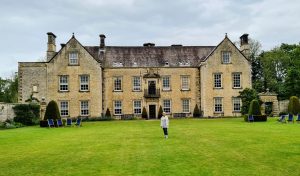
As we arrived we saw an otter disappearing in the river – the River Rye. Sadly it remained disappeared for the rest of our visit. So, no photos.
The tour of the house was rather good (everything being relative). It seemed informal and friendly – and the rooms were well lit (unlike many NT places).
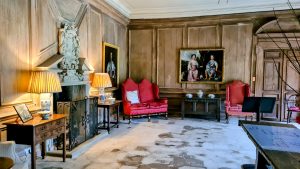
And on the top floor we found an interesting exhibition of art work related to the Rye Valley. Plus a collection of incredibly detailed dolls house style rooms.
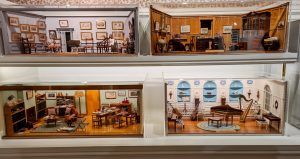
Afterwards, (and I’ve just discovered that May 20th was, in fact, WORLD Bee Day) we joined a 20 minute introduction to the bees of the garden. Well, Glenda joined it. I spent the first 10 minutes wandering around the garden looking for the tour group! The guide was steeped in enthusiasm for the little critters. And luckily for me, his 20 minute talk turned into a 70 minute-only-to- be-terminated-by-a-short-sharp-shower event. In that time we found nine different species of bee (of the approximate total of 270 UK species), including one suspected of being a “cuckoo bumble bee”. I had no idea such bees existed!
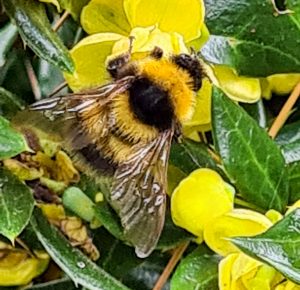

Cuckoo bumble bee queens employ sophisticated con artistry to infiltrate the nests of their hosts, but they don’t simply dump their eggs in another bumble bee nest, like a cuckoo bird. Because their host bumble bees are social insects, cuckoo bumble bees have to trick the entire colony into rearing the cuckoo brood, not just mum and dad.
Cuckoo bumble bees, and there are six known species in the UK, cannot produce their own workers, they lack pollen baskets on their legs and so cannot collect pollen to feed their own offspring, and they cannot produce enough wax to build their own nest. So they have to find a suitable sized nest of their host and rely on them to rear their young! But getting in can be tricky – some mimic the scent of their hosts-to-be. Others have almost no scent of their own but pick up the hosts’ pheromones as they move about the nest. As a back up, they have stronger body armour and wicked stings!
Our guide explained the custom made nest boxes for masonry bees (of which there are allegedly at least 20 species found in the UK).
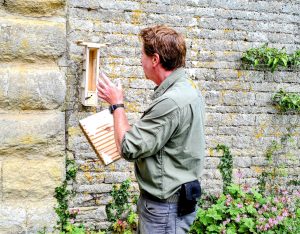
Each species needs an exact size hole to attract them to use these “artificial holes in the wall”. This box had 8 mm holes.
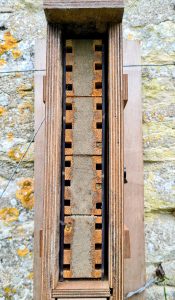
The central section can be slid out for ease of observation …
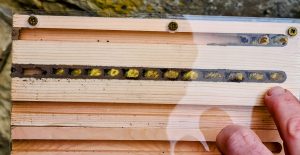
An individual female bee will take up residence in one tube. She will lay a single egg at the back, then seal it in with mud before laying another and repeating the walling in process. When all her eggs (about 15-20) are laid, the hole is sealed off (as can be seen on some of the tubes in the close-up, face view above.) Cleverly, the last eggs to be laid in the hole will hatch as males, so they will be hanging about ready to fertilise the females which will hatch a little later.
Allegedly, masonry bees can be 800 times more effective as pollinators than honey bees. But how that statistic can be measured or, indeed, verified is beyond me!
There are also about 100 species of British miner bees, but these were all staying underground as the weather wasn’t sunny enough to get them out and about.
I hope you wanted a lesson on bees!
Another day we hit Thirsk. A lovely Yorkshire Market town and home to Alf Wight, later to become famous as the fictional James Herriot.
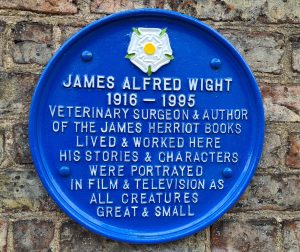
The.house where Alf lived and practised as a vet is now a museum – “The World of James Herriot”. There is a huge amount of information about the real life characters on which the stories are based. The place is stuffed full of all things veterinarian and mementos of life in rural Yorkshire in the middle of the last century.
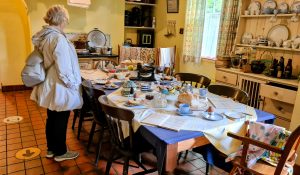
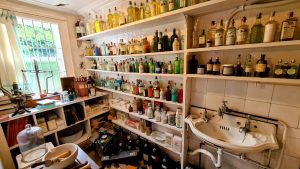
The old Austin with the sliding passenger seat is displayed …
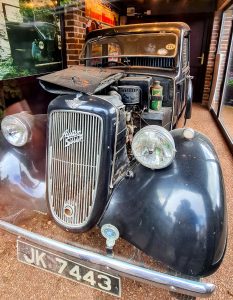
… and the film set of the vets’ lounge has been recreated here …

… with Glenda audtioning for the part of Mrs Hall in the next series!
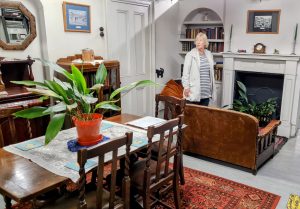
Here’s a question for you. How many televised episodes were made of All Creatures Great and Small with Timothy Christopher as James? Have a guess and I’ll tell you later.
The advice is to allow 90 minutes to take it all in. We were there welk over two hours and could have spent longer, but we reached information overload and had to abandon ship! It was a really good visit – much enjoyed!
Back in the 21st century, we found Thirsk gearing up for the Queen’s platinum jubilee celebrations. All the bollards have been given knitted embellishments!
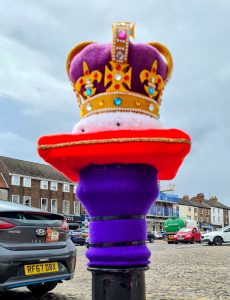
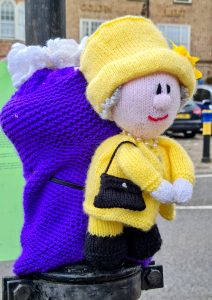
How wacky is that?
No visit to this part of the world would be complete without a day trip to Barnard Castle. There do seem to be a lot of opticians in town, and as I needed some eye drops, I did call in on one. It just had to be done. I think the optician who examined me thought I was having a laugh! (For those of you who don’t keep up with UK news, a certain controversial, political aide had driven to Durham (potentially illegally, during Covid lock-down). He later drove 25 miles to Barnard Castle again during lock-down “to test that his eyes were OK for him to drive to London!” Yeah, right!)
The castle is a not very spectacular ruin from outside.

I didn’t have time to explore fully, but I can confirm that Richard III doesn’t live there anymore. I know that because they found him under a car park in Leicester about ten years ago.
Bowes museum is located on the edge of town and looks an impressive place …

But this is a place for a long visit and we are meeting Lesley and Ian (yet more friends from university days!) at Stoneygate Farm shop and cafe in half an hour.
A final meal at the Wellington Heifer in Ainderby Steeple with Sarah and Ian, and our 700th night was spent in our caravan. And we’ve only owned it foreight years!
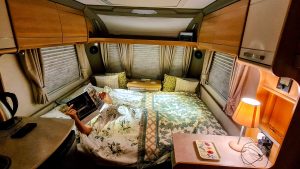
We were off crack of dawn the next day. Well, OK, we had to have the £7.00 full breakfast at the Romanby golf club first. A bargain can’t be missed! As the chef doesn’t get to work before 10 am, and we champing at the bit to get moving, we did have the barman get the ovens switched on and fired up ready!
And so we leave the Northallerton area, still with so much to do and see!
Quiz answer: There were 91 episodes in seven series! (My guess had been 18-20!)
